From butter and oil to simply eating out of hand, the peanut has long held a prominent spot in the American foodscape. But, the National Peanut Board notes that a relative newcomer to the peanut lineup is catching on in culinary and processing circles these days: peanut flour.
Peanut flour, either conventional or organic, is derived from blanched, high-oleic peanuts roasted to various degrees—light, medium and dark—to deliver everything from bland to bold peanut flavor. They’re then defatted via a mechanical, solvent-free process to fat levels of 12% or 28%. Like peanuts, most of the fat in peanut flour is monounsaturated and polyunsaturated. Compared to peanut butter, the lower fat level in peanut flour helps improve the shelf life of products. Although peanuts generally contain about 25% high-quality protein, removing part of the oil before grinding ups that percentage to around 50% in the 12%-fat flour and 40% in the 28%-fat flour. Moisture content in both flours is typically less than 2.0%.
Fat level plays a role in the degree of peanut flavor, with 28%-fat flour delivering a more-pronounced peanut flavor. The 12%-fat flour is best for high-protein, low-fat applications like nutritional and snack bars, where the bold peanut flavor can help mask off notes in highly fortified foods, as well as low-fat baked goods, notes Bruce Kotz, vice president, specialty products, Golden Peanut Company, Alpharetta, GA. The 28% flour often goes into confections, peanut-butter coatings, fillings, frostings and baked goods.
Peanut flour can replace peanut butter “in formulations where you want to control the fat migration of peanut-butter-filled items,” says Kotz, noting the higher fat levels in peanut butter can cause shelf-life problems when it is in contact with a cookie or cracker, or chocolate. “Peanut flour is very easy to work with compared to peanut butter.”
Naturally gluten-free peanut flour adds flavor and aroma to breads and pastry, where formulators can replace a portion of a product’s wheat flour with defatted peanut flour; Kotz recommends 25% replacement as a starting point. Recent recipes developed for the National Peanut Board include a dessert pizza with peanut flour in the crust, and a savory Yucatan mole pork crêpe with peanut flour in the crêpe wrap (and peanut butter in the mole sauce). Peanut flour also coats meats, fish and other proteins, lending a nutty flavor to foods, and adds viscosity to marinades, sauces and dressings.
According to USDA Agricultural Research Service studies, lower-fat, lightly roasted flours have been found to serve as better thickeners than higher-fat peanut flours (see ars.usda.gov/is/pr/2007/070125.htm).
National Peanut Board
2839 Paces Ferry Road, Suite 210
Atlanta, GA 30339
Phone: 678/424-5750
866/825-7946
Fax: 678/424-5751
E-mail:
Website: nationalpeanutboard.org








